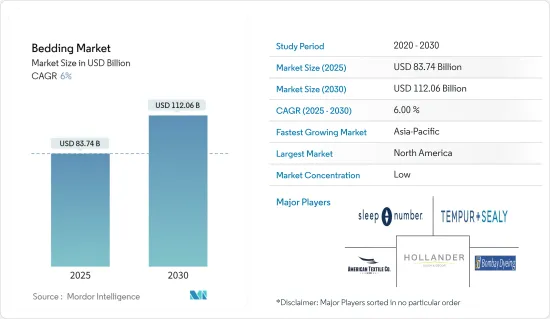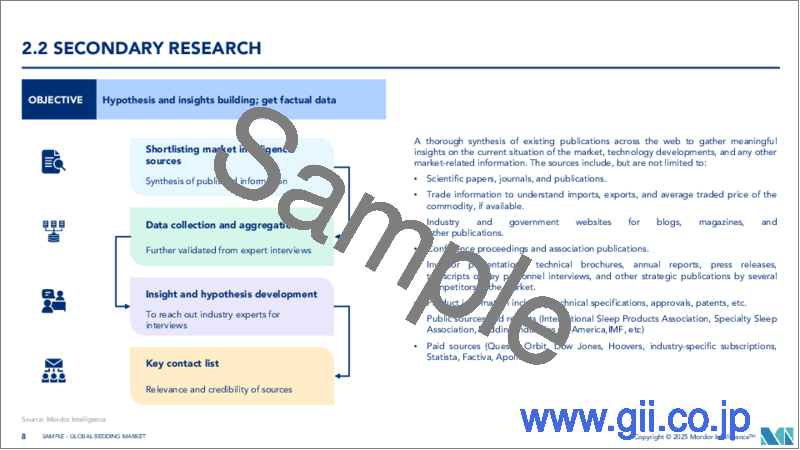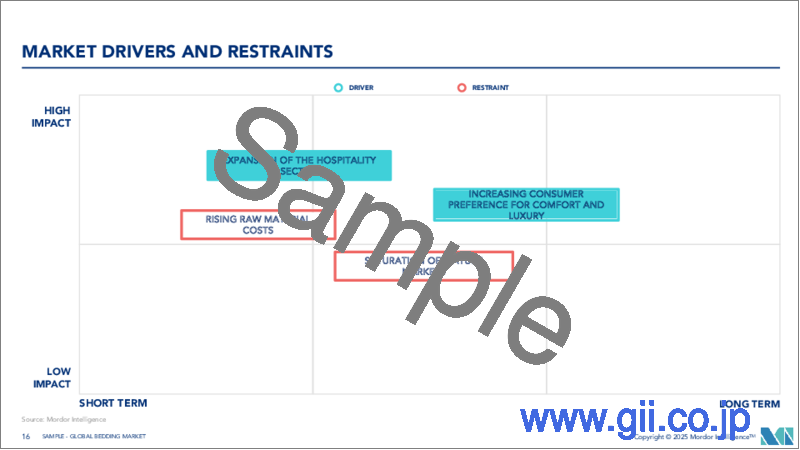|
|
市場調査レポート
商品コード
1636094
寝具:市場シェア分析、産業動向・統計、成長予測(2025~2030年)Bedding - Market Share Analysis, Industry Trends & Statistics, Growth Forecasts (2025 - 2030) |
||||||
カスタマイズ可能
適宜更新あり
|
|||||||
| 寝具:市場シェア分析、産業動向・統計、成長予測(2025~2030年) |
|
出版日: 2025年01月05日
発行: Mordor Intelligence
ページ情報: 英文 120 Pages
納期: 2~3営業日
|
全表示
- 概要
- 目次
寝具の市場規模は2025年に837億4,000万米ドルと推計され、予測期間中(2025-2030年)のCAGRは6%で、2030年には1,120億6,000万米ドルに達すると予測されます。

寝具市場は活況を呈しており、さまざまな需要や嗜好に対応できる幅広い商品を提供しています。近年、高品質で高級な寝具への需要が高まっています。消費者は寝室を快適にするだけでなく、エレガントでスタイリッシュな寝具を求めています。そのため、エジプト綿、シルク、竹などの高級寝具素材が増加しました。
持続可能性への注目が高まる中、寝具市場では環境に優しく持続可能な寝具製品に対する需要が急増しました。また、モノのインターネット(IoT)の台頭により、スマート寝具の人気が高まっています。スマート寝具には、温度調節シーツ、睡眠追跡マットレス、スピーカー内蔵枕などがあります。消費者は、快適で耐久性があり、見た目にも美しい寝具製品をますます求めるようになっています。そのため、革新的で高品質の寝具製品に対する需要が高まっています。現在、多くの企業がカスタマイズ可能な寝具を提供しており、消費者はシーツ、枕カバー、布団カバーの色、柄、生地を選ぶことができます。
寝具市場の動向
家庭用寝具が市場を席巻
家庭用寝具分野は、他の市場分野よりも高い成長を遂げています。この成長の背景には、消費者の嗜好の変化、可処分所得の増加、良質な睡眠衛生の重要性に対する意識の高まりなど、いくつかの要因があります。消費者は、睡眠体験を高めるために高品質で快適な寝具製品を求めるようになっており、これが家庭用寝具製品の需要急増につながっています。さらに、さまざまなサイズ、色、デザインの寝具製品が幅広く入手できるようになったことが、この分野の成長をさらに後押ししました。
eコマースの成長も、家庭用寝具市場の成長に大きな役割を果たしました。消費者は、利便性、手頃な価格、幅広い製品ラインナップを求めて、ますますオンライン・ショッピングを利用するようになっているからです。全体として、家庭用寝具市場は、高品質かつ快適な寝具製品に対する消費者の需要の高まりによって、今後数年間で成長すると予想されます。
eコマースが市場を牽引
eコマースの成長も家庭用寝具市場の成長に重要な役割を果たしています。消費者は利便性、手頃な価格、幅広い商品ラインナップを求めて、ますますオンラインショッピングを利用するようになっているからです。近年、eコマースは寝具市場の大きな原動力となっています。
オンライン・ショッピングは、消費者の寝具製品の購入方法に革命をもたらし、従来の実店舗よりも利便性が高く、品揃えも豊富で、価格も安いことが多いです。eコマースはまた、寝具メーカーがより多くの消費者にリーチし、顧客層を拡大し、売上を伸ばすことを可能にしました。Amazon、Wayfair、Overstockのようなオンラインマーケットプレースは、寝具製品のショッピングの人気スポットとなった。また、多くの寝具メーカーがeコマース・ウェブサイトを立ち上げ、従来の小売チャネルをバイパスして消費者に直接販売できるようになった。
さらに、eコマースによって、寝具メーカーは顧客によりパーソナライズされたショッピング体験を提供できるようになった。データ分析と機械学習を利用することで、企業は顧客の嗜好や行動を分析し、パーソナライズされた推奨や商品提供を行うことができます。これは顧客満足度とロイヤルティの向上に役立った。
寝具業界の概要
調査対象市場は世界的に競合が激しく、断片化しています。技術の進歩と製品の革新により、中堅から中小企業は新規契約を獲得し、新規市場を開拓することで市場での存在感を高めています。大手ブランドは、特別な商品を扱う専売店をオープンしています。各社はまた、市場での知名度とブランド認知度を高めるために、限定版の販売促進、差別化、販売も行っています。本レポートでは、世界の寝具市場で事業を展開する主要な国際企業を取り上げています。主な参入企業は、Acton &Acton Ltd.、American Textile Company、Tempur Sealy International, Inc.、Sleep Number Corporation、Bombay Dyeingです。
その他の特典
- エクセル形式の市場予測(ME)シート
- 3ヶ月間のアナリスト・サポート
目次
第1章 イントロダクション
- 調査の前提条件と市場定義
- 調査範囲
第2章 調査手法
第3章 エグゼクティブサマリー
第4章 市場の洞察と力学
- 市場概要
- 市場促進要因
- 市場抑制要因
- 産業バリューチェーン分析
- 業界の魅力度ポーターのファイブフォース分析
- 供給企業の交渉力
- 買い手の交渉力
- 新規参入業者の脅威
- 代替品の脅威
- 競争企業間の敵対関係
- 業界の技術的進歩に関する洞察
- COVID-19の市場への影響
第5章 市場セグメンテーション
- タイプ別
- 家庭用寝具
- ホテル用寝具
- 流通チャネル別
- スーパーマーケット/ハイパーマーケット
- 専門店
- オンライン
- その他の流通チャネル
- 地域別
- 北米
- 米国
- カナダ
- メキシコ
- その他北米
- アジア太平洋地域
- インド
- 中国
- オーストラリア
- その他アジア太平洋地域
- 欧州
- ドイツ
- 英国
- その他欧州
- 南米
- ブラジル
- アルゼンチン
- その他南米
- 中東・アフリカ
- アラブ首長国連邦
- サウジアラビア
- 南アフリカ
- その他中東とアフリカ
- 北米
第6章 競合情勢
- 市場集中の概要
- 企業プロファイル
- American Textile Company
- Tempur Sealy International, Inc.
- Sleep Number Corporation
- Bombay Dyeing
- Casper Sleep Inc.
- Hollander Sleep Products LLC
- Beaumont & Brown
- Pacific Coast Feather Company
- Crane & Canopy Inc.
- Serta Simmons Bedding
- The White Company Portico New York
- Best Bed Linen Ltd.
- Boll and Branch LLC
- Serena and Lily Inc.*
第7章 市場機会と今後の動向
第8章 免責事項と出版社について
The Bedding Market size is estimated at USD 83.74 billion in 2025, and is expected to reach USD 112.06 billion by 2030, at a CAGR of 6% during the forecast period (2025-2030).

The bedding market is booming and offers a wide range of goods to accommodate a variety of demands and preferences. In recent years, there has been a growing demand for high-quality and luxurious bedding. Consumers are searching for bedding that will not only make their bedrooms more comfortable but also elegant and stylish. This has led to an increase in the availability of premium bedding materials such as Egyptian cotton, silk, and bamboo.
With an increasing focus on sustainability, the bedding market witnessed a surge in demand for eco-friendly and sustainable bedding products. Also, smart bedding became increasingly popular with the rise of the Internet of Things (IoT). Smart bedding includes temperature-regulating sheets, sleep-tracking mattresses, and pillows with built-in speakers. Consumers are increasingly looking for bedding products that are comfortable, durable, and visually appealing. It led to a rise in demand for innovative and high-quality bedding products. Many companies now offer customizable bedding options, allowing consumers to choose the colors, patterns, and fabrics for their sheets, pillowcases, and duvet covers.
Bedding Market Trends
Home Bedding is Dominating the Market
The home bedding segment was experiencing higher growth than other market segments. This growth is driven by several factors, including changing consumer preferences, increasing disposable incomes, and rising awareness about the importance of good sleep hygiene. Consumers are increasingly looking for high-quality and comfortable bedding products to enhance their sleep experience, which led to a surge in demand for home bedding products. Moreover, a wide range availability of bedding products in various sizes, colors, and designs further fueled this segment's growth.
The e-commerce growth also played a significant role in the growth of the home bedding market, as consumers are increasingly turning to online shopping for convenience, affordability, and a wider range of products to choose from. Overall, the home bedding market is expected to grow in the coming years, driven by consumers' increasing demand for high-quality, comfortable bedding products.
E Commerce is Driving the Market
The growth of e-commerce also played a significant role in the growth of the home bedding market, as consumers are increasingly turning to online shopping for convenience, affordability, and a wider range of products to choose from. Recently, e-commerce is a major driving force in the bedding market.
Online shopping revolutionized how consumers buy bedding products, providing greater convenience, selection, and often lower prices than traditional brick-and-mortar stores. E-commerce also allowed bedding companies to reach a wider audience, expand their customer base, and increase sales. Online marketplaces such as Amazon, Wayfair, and Overstock became popular destinations for bedding product shopping. Many bedding companies also launched e-commerce websites, allowing them to sell directly to consumers and bypass traditional retail channels.
Furthermore, e-commerce enabled bedding companies to provide customers with a more personalized shopping experience. Using data analytics and machine learning, companies can analyze customer preferences and behavior and provide personalized recommendations and product offerings. It helped improve customer satisfaction and loyalty.
Bedding Industry Overview
The market studied is competitive and fragmented globally. With technological advancements and product innovations, midsize to smaller companies are increasing their market presence by securing new contracts and tapping into new markets. The leading brands are opening exclusive stores for special products. The companies are also promoting, differentiating, and selling limited editions to increase their visibility and brand awareness in the market. The report covers major international players operating in the global bedding market. The major players in the market are Acton & Acton Ltd., American Textile Company, Tempur Sealy International, Inc., Sleep Number Corporation, and Bombay Dyeing.
Additional Benefits:
- The market estimate (ME) sheet in Excel format
- 3 months of analyst support
TABLE OF CONTENTS
1 INTRODUCTION
- 1.1 Study Assumptions and Market Definition
- 1.2 Scope of the Study
2 RESEARCH METHODOLOGY
3 EXECUTIVE SUMMARY
4 MARKET INSIGHTS AND DYNAMICS
- 4.1 Market Overview
- 4.2 Market Drivers
- 4.3 Market Restraints
- 4.4 Industry Value Chain Analysis
- 4.5 Industry Attractiveness: Porter's Five Forces Analysis
- 4.5.1 Bargaining Power of Suppliers
- 4.5.2 Bargaining Power of Buyers
- 4.5.3 Threat of New Entrants
- 4.5.4 Threat of Substitutes
- 4.5.5 Intensity of Competitive Rivalry
- 4.6 Insights into Technological Advancements in the Industry
- 4.7 Impact of COVID-19 on the Market
5 MARKET SEGMENTATION
- 5.1 By Type
- 5.1.1 Home Bedding
- 5.1.2 Hotel Bedding
- 5.2 By Distribution Channel
- 5.2.1 Supermarkets / Hypermarkets
- 5.2.2 Specialty Stores
- 5.2.3 Online
- 5.2.4 Other Distribution Channels
- 5.3 By Geography
- 5.3.1 North America
- 5.3.1.1 United States
- 5.3.1.2 Canada
- 5.3.1.3 Mexico
- 5.3.1.4 Rest of the North America
- 5.3.2 Asia-Pacific
- 5.3.2.1 India
- 5.3.2.2 China
- 5.3.2.3 Australia
- 5.3.2.4 Rest of the Asia-Pacific
- 5.3.3 Europe
- 5.3.3.1 Germany
- 5.3.3.2 United Kingdom
- 5.3.3.3 Rest of the Europe
- 5.3.4 South America
- 5.3.4.1 Brazil
- 5.3.4.2 Argentina
- 5.3.4.3 Rest of the South America
- 5.3.5 Middle East and Africa
- 5.3.5.1 United Arab Emirates
- 5.3.5.2 Saudi Arabia
- 5.3.5.3 South Africa
- 5.3.5.4 Rest of the Middle East and Africa
- 5.3.1 North America
6 COMPETITIVE LANDSCAPE
- 6.1 Market Concentration Overview
- 6.2 Company Profiles
- 6.2.1 American Textile Company
- 6.2.2 Tempur Sealy International, Inc.
- 6.2.3 Sleep Number Corporation
- 6.2.4 Bombay Dyeing
- 6.2.5 Casper Sleep Inc.
- 6.2.6 Hollander Sleep Products LLC
- 6.2.7 Beaumont & Brown
- 6.2.8 Pacific Coast Feather Company
- 6.2.9 Crane & Canopy Inc.
- 6.2.10 Serta Simmons Bedding
- 6.2.11 The White Company Portico New York
- 6.2.12 Best Bed Linen Ltd.
- 6.2.13 Boll and Branch LLC
- 6.2.14 Serena and Lily Inc.*






